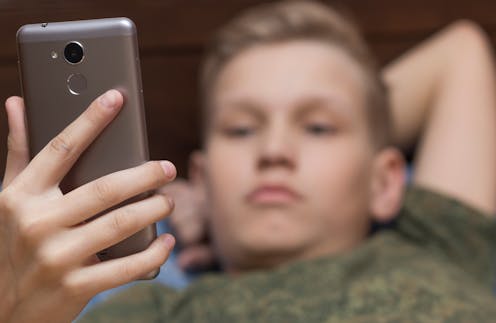
Parents, teachers and politicians are worried about the appeal of so-called “online misogyny influencers” to boys and young men.
These influencers post content to thousands of followers in videos and podcasts, offering advice about relationships, mental health and wellbeing, and achieving material success and status. They are believed to be having a negative effect on young men’s attitudes, beliefs and expectations, including about gender roles and relationships between men and women.
I’ve carried out extensive research with young people about sex and relationships for nearly a decade. We need to ask what the appeal of misogyny influencers among some young men tells us about how they feel about themselves, and what it means to be a man right now.
We also need to question what it tells us about our society’s failures to take the challenges young men face seriously. There seems to be a vacuum for these influencers to fill.
I use the term “misogynistic” to refer to clear expressions of outright hatred or dislike of women and girls – but also, more broadly, to the sharing of sexist ideas about both males and females.
Finding an audience
We can understand the appeal of misogyny influencers by thinking about “push”, “pull” and “personal” factors.
Push factors come from the situations in which young men find themselves in society that makes misogyny influencers’ content resonate. One example is the perception that women and girls are achieving more in the workplace and at school, and that as a result, men and boys are being disadvantaged and left behind in terms of the opportunities and support available to them.
Pull factors are the tactics misogyny influencers use to enhance their appeal. These include the use of appealing visual content and sophisticated social media manipulation. They are able to create intense emotional responses through extreme messaging, while providing a community of like-minded others.
Personal factors then explain the different levels of vulnerability to the negative effect of these influencers among young men. Those who more acutely feel the pressure of expectations about masculinity from their peers may be particularly vulnerable.
This includes, for example, young men who are socially isolated or excluded, or those whose peers expect and celebrate forms of masculinity based on dominance and the heterosexual pursuit of, and success with, young women.
In research I conducted with boys aged 12 to 17 about sexual consent, I found they want consensual sexual interactions with girls but are concerned about dealing with the complexities of consent. They felt responsible as the supposed “initiators” of sex to seek and obtain consent. Most had been warned they may get into trouble legally if sex is not consensual.
For many, therefore, heterosexual interactions are fraught with the risk of unwanted sex – and of possible legal implications if a girl or young woman claims that sex is non-consensual.
But some of the boys also expressed hostile sentiments about girls and women, such as that they might “lie” about being sexually assaulted. Adults such as teachers may feel they need to shut down beliefs like this in an effort to take a zero-tolerance approach to the underlying causes of sexual harm – but this may lead to boys and young men feeling unheard.
I have found that their attitudes often reflect deeper-rooted uncertainties and anxieties that are not being meaningfully recognised or addressed.
Idealised masculinity
Misogyny influencers such as Andrew Tate seem to provide boys and young men with a solution to these challenges, and a way to make sense of their feelings and experiences. Their solution often involves criticising progressive gender politics which, they argue, is damaging for both men and women. They in turn advocate a return to traditional gender roles.
These influencers present a celebratory version of masculinity. They legitimise, even agitate, male grievances and resentment, including towards women. Their content may be enticing to boys and young men who feel masculinity is being unfairly stigmatised and blamed.

It is a simplistic and divisive message. This form of masculinity is unlikely to be attainable, and may not even be desirable – a boy interviewed as part of my research said that “what most people want from a relationship is a nice relationship”.
Boys’ responses to such influencers are also likely to be nuanced. A report by the Global Boyhood Initiative, which provides resources as part of gender equality non-profit Equimundo, suggests that boys and young men hold different opinions about masculinity and have diverse masculine identities as individuals.
This suggests that some young men do not see masculinity displays such as those by Tate as something to be mindlessly copied or aspired to in full.
Furthermore, teenagers are attracted to risk and rebellion. The more that adults lecture boys and young men about the evils of misogyny influencers, the more attractive they may become, as they offer an opportunity to resist and rebel against adult norms.
It is therefore not enough to say the influencers are wrong or that young men should feel ashamed for liking them. We also need to offer a credible alternative.
Read more: Andrew Tate: how the 'manosphere' influencer is selling extreme masculinity to young men
Perhaps, though, we don’t yet know that alternative. As a society, we’re arguably still trying to figure out gender roles and relations and have not yet achieved consensus. We should, therefore, avoid shutting down, correcting or, worse, shaming young men who are grappling with these complexities.
Misogyny influencers are telling young men that no one is listening and they are being silenced, especially by people the influencers may consider feminist “man-haters”.
I’d suggest that it’s time to start listening more closely to boys and young men. We need to offer them the opportunity to play a positive role in identifying problems with misogynist beliefs, as well as developing other ways to view their place in society.
Emily Setty receives funding from the University of Surrey through internal grants, eNurture UKRI, the Leverhulme Trust, the British Academy, and the Economic and Social Research Council.
This article was originally published on The Conversation. Read the original article.







